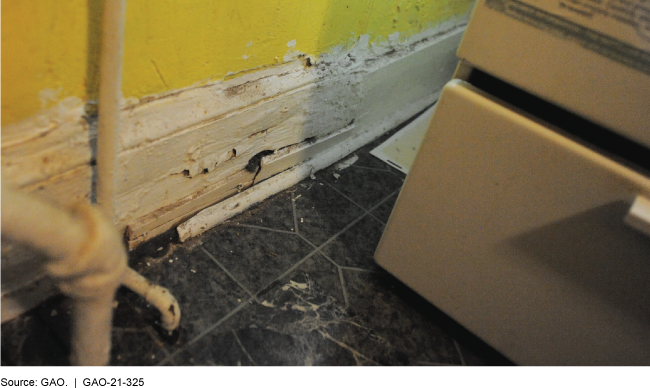Lead Paint in Housing: Key Considerations for Adopting Stricter Lead Evaluation Methods in HUD's Voucher Program
Fast Facts
Lead paint can seriously affect young children's health and has been banned from use in U.S. housing since 1978.
Housing and Urban Development's voucher program has 1.1 million families living in housing units built before 1978—including about 229,000 children under 6 years old (who are at greatest risk from lead exposure). These units are visually examined for deteriorated paint, but aren't tested.
Estimated costs for lead evaluations vary. Costs range from $60 million (only evaluating units with young children) to $880 million (evaluating all units). This would equate to 3%-41% of the voucher program's FY 2021 administrative expenses.
Example of A Home with Deteriorated Paint

Highlights
What GAO Found
GAO found that the Housing Choice Voucher program had 1.1 million voucher holders living in units built before 1978, the year the U.S. banned lead paint in housing. Of these units, roughly 171,000 were occupied by approximately 229,000 young children (under age 6)––putting these children at an increased risk of lead exposure. The voucher program requires visual assessments for identifying deteriorated paint, with no testing of paint or dust. Any change to stricter evaluation methods would need to consider that certain states have a larger portion of pre-1978 voucher units occupied by families with young children.
Estimated costs for adopting stricter lead evaluation methods for the voucher program would vary substantially depending on the method used and what units were included (see figure). Estimated initial costs range from about $60 million for a less expensive method applied only to units with young children to about $880 million for a more expensive method applied to all pre-1978 units. These estimated costs range from 3 percent to 41 percent, respectively, of the fiscal year 2021 budget dedicated to public housing agencies' administrative expenses for the voucher program. Total costs would also depend on the mobility of voucher households and the frequency of any additional lead evaluations.
Total Estimated Cost to Change the Lead Evaluation Methods for Housing Choice Voucher Units Would Vary by Evaluation Method Used and Units Included

Note: A combination evaluation includes all components of a lead inspection and a risk assessment. Estimated costs may vary by up to plus or minus 14 percentage points at the 95 percent level of confidence.
GAO analysis estimated that nearly 6,000 lead professionals can conduct lead evaluations in the U.S. While there is no indication of a national shortage of lead professionals, areas with high numbers of pre-1978 voucher units and low numbers of lead professionals may face implementation challenges.
Selected cities offer observations from their implementation of a change in lead evaluation method. For example, education of landlords can help clarify new evaluation requirements and encourage landlords to continue to rent to voucher holders. Further, implementing a new method in phases could target areas with the greatest need and help landlords and the industry adapt to the new requirement and the increased demand for lead evaluations.
Why GAO Did This Study
Exposure to lead paint, which was used in housing built before 1978, can have serious health effects, especially for young children. The Department of Housing and Urban Development (HUD) has primary responsibility for identifying lead paint hazards in housing receiving HUD assistance, including private rental units in the voucher program. Some members of Congress have raised questions about whether the voucher program should change from visual assessments to a stricter lead evaluation method.
The 2017 Consolidated Appropriations Act, Joint Explanatory Statement, includes a provision for GAO to review HUD's efforts to address lead paint hazards. This report identifies considerations for policymakers related to changing to stricter lead evaluation methods for the voucher program, specifically regarding the (1) number and characteristics of voucher housing units and their occupants, (2) costs for lead evaluations based on method used and units included, (3) availability of lead professionals, and (4) observations from selected cities that use lead evaluation methods stricter than visual assessments.
GAO analyzed HUD data on the voucher program (as of year-end 2019, the most recent available) and information on lead professionals from the Environmental Protection Agency (EPA) and states. GAO also conducted a nationwide, generalizable survey of lead professionals to estimate the costs of lead evaluation methods. In addition, GAO interviewed staff from HUD, EPA, and public housing agencies, and representatives from two national organizations that represent lead professionals.
For more information, contact John H. Pendleton at (202) 512-8678 or pendletonj@gao.gov.
